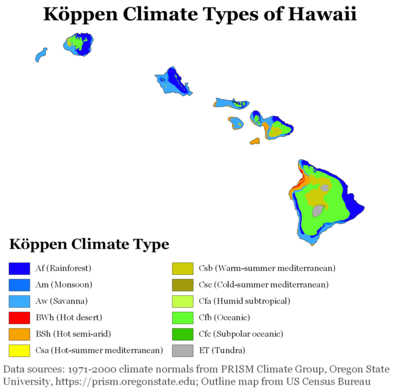
The U.S. state of Hawaiʻi, which covers the Hawaiian Islands, is tropical but it experiences many different climates, depending on altitude and surroundings. The island of Hawaiʻi for example hosts four (out of five in total) climate groups on a surface as small as 4,028 square miles (10,430 km2) according to the Köppen climate types: tropical, arid, temperate and polar. When counting also the Köppen sub-categories – notably including the very rare cold-summer mediterranean climate – the island of Hawaiʻi hosts 10 (out of 14 in total) climate zones.[1] The islands receive most rainfall from the trade winds on their north and east flanks (the windward side) as a result of orographic precipitation. Coastal areas are drier, especially the south and west side or leeward sides.[2]
Overall with climate change, Hawaiʻi is getting drier and hotter.[3][4] The Hawaiian Islands receive most of their precipitation from October to April. Drier conditions generally prevail from May to September. Due to cooler waters around Hawaiʻi, the risk of tropical cyclones is low for Hawaiʻi.
- ^ "Island of Hawai'i: climate zones". lovebigisland.com. Retrieved January 2, 2017.
- ^ Hartmann, D.L. (2003), "CLIMATE | Overview", Encyclopedia of Atmospheric Sciences, Elsevier, pp. 403–411, doi:10.1016/b0-12-227090-8/00024-5, ISBN 978-0-12-227090-1
- ^ "Less & Heavy Rain". State of Hawaii. Retrieved June 11, 2023.
- ^ "Rising temperatures". State of Hawaii. Retrieved June 11, 2023.